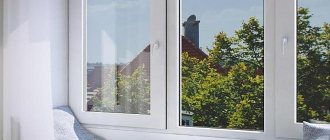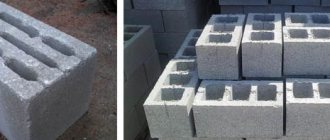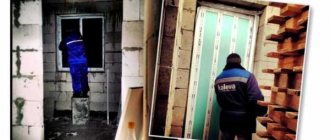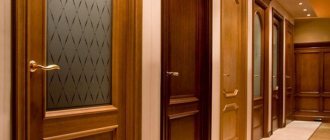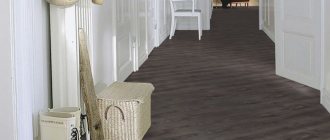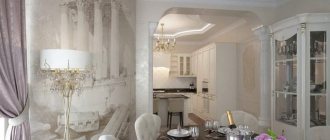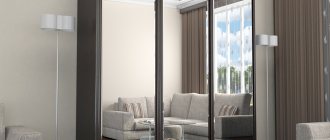Why are doors with a thermal break necessary?
An ordinary , albeit very durable, metal entrance door without a thermal break has a lot of disadvantages, including:
- heat leakage through the canvas, since metal has high thermal conductivity;
- the formation of condensation from the inside of the door, as the leaf is greatly cooled and moisture from the air begins to condense on its surface. There can be so much condensation that puddles may form under the door;
- Condensation at sufficiently low temperatures turns into frost, and at very low temperatures it can cause the door leaf to freeze to the frame or lead to the lock freezing.
Not only is wiping the canvas and puddles under it, and sometimes even warming up the door, not the most interesting activity, but the structure itself can suffer significantly. Constantly increased humidity leads to the formation of corrosion, deformation and depressurization of the circuit , i.e. The service life of the door is reduced.
How to get rid of this drawback of metal doors that are so practical in all other respects? Initially, insulated doors were used to solve the problem. The presence of thermal insulation material makes it possible to reduce heat loss and shift the dew point into the insulation, but the problem of condensation still remains, since the presence of cold bridges - points of contact between the inner and outer parts of the door - cannot be ruled out. To finally rid the doors of the problem of condensation and freezing, it is necessary to completely isolate the outer part from the inner part, which is made possible thanks to a thermal break.
What are the advantages of such door designs?
Doors with similar technologies have a number of advantages over conventional doors:
- The design helps to save internal heat in the room, and accordingly the consumption for heating the internal space decreases.
- According to consumer reviews, no condensation, no frost, or ice never forms on thermal doors. The absence of such formations on the door leaf significantly increases the service life of the structure and allows it to maintain an attractive appearance for a long time.
- The input device with a thermal break is treated with an additional coating with corrosion protection.
However, any most reliable thermal door must also meet other requirements that apply to high-quality entrance structures:
- The canvas must be perfectly smooth. Without bevels, distortions, tilts and other types of deformation on the surface.
- It is best if an additional rubber seal is reinforced along the entire perimeter of the canvas - this will further enhance the heat-preserving functions of the structure as a whole.
- Pay attention to the installation of the device. If the installation technology is incorrect, all the beneficial properties of the door will be reduced to zero.
Our showrooms feature doors with thermal breaks made in Russia (Fortezza, Torex, Bulldors, Monarch), both with and without moisture-resistant MDF panels.
But no matter how warm the door is, in our Siberian climate we cannot do without such an invention as a thermal box . Thermal box will help prevent doors from freezing and keep your home warm.
What is thermal break? Door design with thermal break
Doors with a thermal break are a very simple and at the same time ingenious invention. The design is based on physical laws. To prevent heat transfer into the door, it is necessary to prevent contact between the two metal parts of the door, and this can be done by using a layer of material with low thermal conductivity. This material, in essence, is a thermal break. This insert is placed between the insulation layer and the metal frame (visible in the image). Design details may vary slightly.
Thermal break allows you to completely eliminate heat leakage from the room, and also forget about the formation of condensation and ice, because the inside of the canvas will not be cooled. A similar result can only be achieved by using a double door, where the air gap plays the role of a thermal break.
Thermal explosion is carried out, as a rule, from polymer materials, less often - from wood. The thickness of the insert may vary. Manufacturers do not hide that such a system remains effective at a temperature difference of no more than 400C. With more significant differences, even doors with a thermal break can “cry”, but, of course, not to the same extent as ordinary metal doors.
Everything else about doors with a thermal break is the same as in ordinary metal doors:
- outer and inner steel sheet 3 mm thick (2 mm is possible, but this is a less safe option). Doors made of too thin steel, although they are cheaper, can be opened almost with a can opener, and even the coolest lock will not save you. Sometimes the internal panel is made of MDF, which makes the design cheaper, but its burglar-resistant qualities will also be lower;
- metal door frame made from a single profile pipe or several parts;
- Stiffening ribs strengthen the structure and act as its skeleton. At least there should be one horizontal and two vertical ribs, but the more, the better;
- insulation fills the voids between the stiffeners;
- the door design also provides for the presence of a seal, and the door itself is installed in the door frame and is held on it by hinges;
- the lock ensures security; in some doors it is additionally protected by a metal plate;
- handle, hinges and eyelet.
When they talk about the thermal break of doors, they usually mean the thermal break of the door leaf, i.e. element that isolates one outer part of the metal from the inner one. However, high-quality doors also have a thermal break in the stiffeners and a thermal break in the frame.
What materials are used for thermal doors?
Let's start with the fact that these materials are called thermal inserts. Materials with low thermal conductivity are used inside them, which eliminates heat exchange between contacting materials. Basically, these are polymers or technical cork.
The following materials are most often used as a seal for doors with a thermal break:
- mineral wool;
- glass wool;
- expanded polystyrene;
- and polyurethane foam (PPU).
Each of these materials has its own advantages and disadvantages. Thus, mineral wool (mineral wool) is a natural and environmentally friendly material that has proven itself in low temperatures, but requires an increase in the thickness of the door. Therefore, it is mainly used for technical and fire doors.
As a rule, more practical materials are used for entrance doors today - polystyrene foam and polyurethane foam (PPU). The latter has the highest thermal insulation rates, with the thinnest layer. Thermal doors with it are thin and light. However, polyurethane foam also has disadvantages: firstly, such insulation will cost more, and secondly, it will be unnatural and non-ecological (since polyurethane foam is a completely synthetic material).
Pros and cons of doors with thermal break
Everything that is written above is, in fact, a listing of the advantages of doors with a thermal break. But to summarize, let’s briefly list all the advantages:
- high rates of heat and sound insulation;
- frost resistance, this is an ideal solution for regions with harsh climates;
- durability;
- the ability to install instead of two separate doors, which saves money and space;
- the attractive appearance is maintained, as with conventional metal doors, but the strength increases.
There are also disadvantages
- the main disadvantage is the higher price, since the design of such doors is more complex;
- For installation, it is necessary to involve real professionals, since installing doors with a thermal break requires taking into account a lot of nuances. If the technology is disrupted even slightly, then almost all the advantages of the design will have to be said goodbye;
- the significant weight of many panels completely excludes independent installation, and also places restrictions on the parameters of the doorway;
- the presence of high-quality ventilation is mandatory, otherwise even a door with a thermal break will not be able to protect you from condensation.
Doors with thermal break from Bastion-S
Reliable burglary-resistant doors with a thermal break are manufactured by Bastion-S. The manufacturer has been present on the market for more than 20 years; to create doors, it uses high-quality factory rolled metal, electric arc welding technology and high-quality components. You can view the range of doors with thermal breaks on the page https://www.bastion-s.ru/dveri-s-termorazryvom. The company's employees perform high-quality installation and service of doors. All installers are professionals with extensive experience.
Someone may quite rightly ask themselves whether it would be easier to take a high-quality wooden door. In principle, it is possible, but keep in mind that it will also not be cheap, it will weigh no less than a high-quality door with a thermal break, but at the same time the wood is subject to temperature deformations, and as a result the door will either barely close or leave gaps through which will easily penetrate the cold. Plus, the tree is afraid of high humidity, which is not uncommon outdoors, so it cannot be done without regular protective treatment.
A real alternative can be a double door , because the air gap works as a good heat insulator. The distance between the canvases can be minimal, or it can be quite significant when a full-fledged vestibule is obtained. Buying and installing two doors is a more troublesome task, and it’s not a fact that you will be able to save money, but you will definitely lose useful space, and installing two doors is not possible everywhere.
Disadvantages of thermal doors
Before purchasing, be sure to study the technical characteristics and parameters of the door design. But remember that all such models have certain disadvantages. These include:
- Large weight of the structure. It will be very difficult to install the product in a private house alone, and not all openings can withstand such a mass.
- High-quality installation. It is important to make sure that the door structure is installed correctly; misalignment, slope and deformation of the leaf can all affect the thermal insulation.
- The doors cannot withstand severe frosts. If you live in the northern regions, then after some time the external insulation will become thinner, which will lead to drafts.
- Supply and exhaust ventilation is required. Thermal doors protect the home from cold, ice and moisture only with a minimum amount of condensation, so the room must have good ventilation.
- Boring and monotonous design. Most models in this category are similar to one another; the designs consist of straight sheets without any decorative inserts.
Related article: Soundproofed entrance doors: types of materials used and selection criteria
Materials for arranging a thermal break
Thermal break can be made from different materials, which naturally affects the performance characteristics of the canvas. Among the most common materials we note:
- PVC is the most budget option, but also the least practical, as it can hardly withstand frost and at temperatures below -250C loses its performance qualities;
- wood is the direct opposite of PVC. It is expensive, but works most effectively as a thermal break. As a rule, oak inserts are used, but there are also models with cork inserts;
- fiberglass perfectly insulates metal parts, but when heated it can release toxic substances, therefore it is not recommended for use in residential premises;
- basalt wool and polystyrene foam are optimal materials in terms of performance and price, a combination of which is used in most modern doors.
Please note that a thermal break can be achieved not only by inserting the appropriate material or attaching it to self-tapping screws and bolt-nuts (which is done in most cases), but also by creating micro-cuts in the box and canvas . Theoretically, if you violate the integrity of the metal, you will be able to break the cold bridges. In practice, micro-incisions are made using a laser, and they do not eliminate the formation of cold bridges, but only reduce their area. Reviews indicate the low effectiveness of this solution, so we will not recommend it.
External and internal finishing
Doors with a thermal break do not differ in appearance from ordinary metal entrance doors. In terms of design, the variety is so wide that everyone can find a suitable solution, and in extreme cases, order a door, because many manufacturers offer such a service.
The external finish of the front door must be resistant to impacts and scratches, and if it goes outside, then, in addition, it must withstand frequent exposure to precipitation and sunlight.
The most popular exterior finishing options:
- Powder coating is obtained by applying special paints to the metal surface, which are baked under high temperature to form a durable, damage-resistant film. The color of the coating can be almost any. Its advantages include low price, strict and laconic appearance, good resistance to precipitation, sunlight, and mechanical damage;
- solid wood is beautiful and expensive. By choosing a specific type of wood and the method of processing it (painting or varnishing, carving), you can obtain the desired appearance of the canvas. Wood has excellent heat and sound insulation qualities. The downside is that it’s easy to leave a scratch on the surface, and besides, wood is afraid of changes in temperature and humidity. In order for the finish to be durable, you will have to regularly treat the wood with protective agents. If the door faces the street, then the treatment will have to be carried out more often, and it is better to have additional protection in the form of a canopy over the entrance to the house;
- MDF panels allow you to perfectly imitate any type of wood, but at the same time they are not so afraid of precipitation and temperature changes. MDF panels are made from wood chips, have a thickness of 7-20 mm, and are covered on top with veneer (a thin cut of natural wood), paint or PVC film with any pattern. The panel can be either absolutely smooth or have a relief, which gives it additional solidity. Most commercially available doors with a thermal break are finished with MDF panels, since this is the optimal combination of price and quality;
- other finishing options (including finishing with vinyl artificial leather, plastic panels or PVC film alone) are almost never used in doors with thermal breaks, as they have dubious operational and decorative qualities.
For interior decoration use:
- Powder coating is practical and inexpensive, but many are not satisfied with the too simple type of finish, which, moreover, does not always fit into the interior of the hallway. If the door leads to the vestibule, then this option is more than acceptable;
- wood is an ideal option for interior decoration. And if such cladding is not recommended for ordinary metal doors (condensation will quickly destroy it), then for doors with a thermal break this is a very suitable solution, although it will not be cheap;
- MDF panels will also not suffer from condensation if the canvas is protected by a thermal break, so they are perfect for interior decoration;
- a mirror is usually used only for partial decoration of the door, but in some cases it can completely occupy the entire space of the door leaf. This is a great way to expand the space of a small hallway and save space for other things, because you don’t have to hang a mirror on one of the walls. True, the mirror weighs a lot. Plus, the front door gets dirty quite quickly, so washing the mirror will become almost a daily task.
Temperature burst principle
If you understand the basics of thermal break technology in entrance door structures, you will understand their reliability in retaining heat, and will contribute to your further choice as protection for your own home.
In cold weather, the temperature of the outer surface of the door drops significantly, the door elements and insulation let the cold in, and the surface on the side of the apartment or house also cools. As a result, the room temperature decreases, and the appearance of condensation on the metal surface cannot be ruled out. Thermal break technology serves as a modern solution to the problem, eliminating the transfer of heat between door surfaces. The metal sheets that make up the door are divided according to the temperature principle, that is, the outer and inner surfaces maintain their own temperature, cold and room temperature, respectively.
Doors based on the principle of temperature separation protect the entrance from the cold. Perfect for country houses, ground floor apartments, and offices with direct access to the street.
Insulation in doors with thermal break
Thermal break can significantly reduce heat transfer between parts of the door leaf, but it is impossible to imagine warm metal doors without a layer of insulation. Therefore, when choosing, you should also pay attention to the material from which the thermal insulation is made. Among the most popular options:
- mineral wool is a material that has excellent heat and sound insulation qualities, does not burn, does not emit harmful substances, but can sag over time, so it is good if additional lathing is provided in the frame;
- penoplex is similar in basic properties to mineral wool, but less resistant to fire;
- polystyrene foam is a budget option, which, nevertheless, has decent heat and sound insulation qualities, but it is highly flammable and does not hold well inside the door, so the gaps between the insulation and the stiffeners must be filled with foam;
- polyurethane foam - a material with excellent heat and sound insulation qualities, is not afraid of temperature changes and humidity, but is more expensive than other insulation materials and is afraid of fire;
- paper and pressed cardboard are cheap, have good thermal insulation properties, but are afraid of moisture, so it is better not to use them in the design of a door that will regularly encounter large temperature differences;
- foam rubber and synthetic winterizer - it seems that they are not so bad, but to achieve more or less worthwhile results you will need a too thick layer.
High-quality thermal insulation is determined not only by the insulation of the door leaf - all metal profiles must be filled with insulation. In addition, a reliable barrier to cold is provided by the presence of a seal along the contour of the door and, of course, the correct installation of the door leaf.
